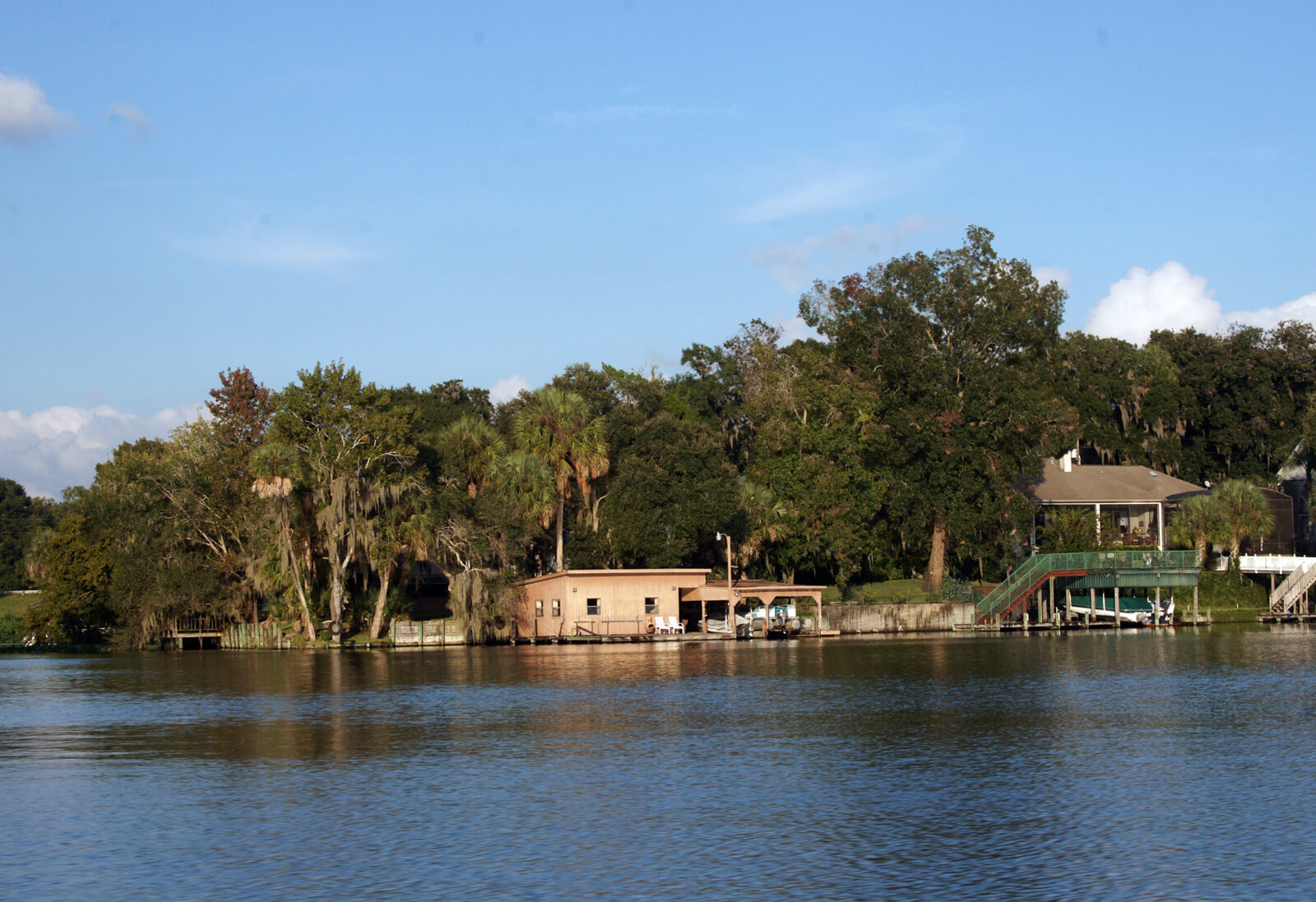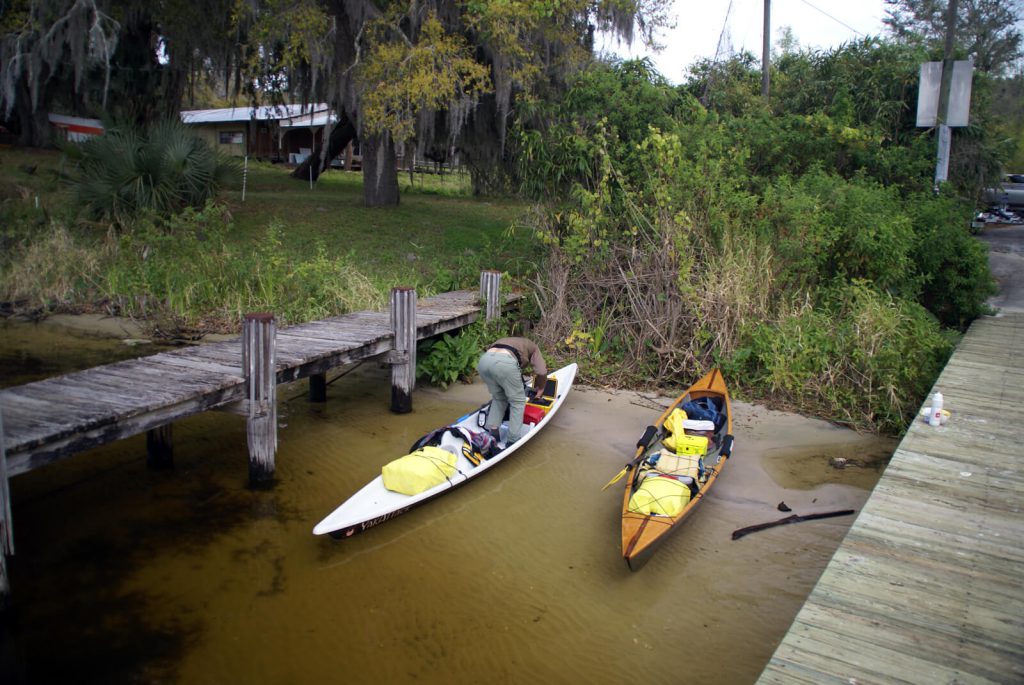14 Saratoga Harbor (Johnson’s Spring)
Putnam County


Set out from the Store, and about 5 miles above, landed on a high bluff, on the east-side of the river, at Johnson’s Spring, a run of clear and sweet water…
John and William Bartram
The Route
On December 27, 1765, John Bartram’s party, having camped at Spalding’s Lower Store boarded their vessel and continued up-river. After rowing an estimated five miles, they stopped beneath a tall bluff at a place John identified as Johnson’s Spring (Figure 1). They left their battoe and proceeded to hike as far south as Welaka Springs, crossing a number of lesser seeps and springs along the way. They retraced their steps to retrieve their vessel and proceed back to a campsite at Johnson’s Bluff, probably in close proximity to Welaka Springs.
It is apparent from their descriptions of the springs and seeps that their hike paralleled the river. The topography in this area is characterized by a good deal of relief which would have afforded the group an interesting and challenging hike which is described in excellent detail in John’s Journal.
The Site
Identifying the location of Johnson’s Spring presents one of the more interesting challenges of the many Bartram Sites in Putnam County. Because springs provide definitive landmarks that seemingly remain unchanged since the visit of the Bartrams, they afford those who desire to stand in the very footprints of John and William the very best and very real opportunity to do so. The challenge however, is to accurately identify the various springs mentioned in the Journal and to match them up with the known springs of today; reconciling the different names which, in many cases, have changed over the intervening centuries.
The challenge presented by Johnson’s Spring arises from the impoundment of what was likely the spring run during the 20th Century to create a series of lakes presently called Saratoga Harbor (Figure 2). The spring or springs have unfortunately never been cataloged and now are invisible beneath the waters of the uppermost lake. While locals share anecdotal accounts of the existence of the springs beneath the lakes, the springs have not be documented and cannot be found in any of the State or Water Management District catalogs of springs in Putnam County. Consequently, the location of the site of the Johnson’s Spring of the Journal is based not on the known location of the spring itself, but rather on the bluff on the east shoreline of the River, its proximity to the site of Spalding’s Lower Store and to the sequence of the crossings of the many seeps and springs described in John’s Journal account of the hike of December 27, 1765.
Matching up the details provided in the Journal with the topography, location and both chemical and physical characteristics of the springs located between Saratoga Harbor and Welaka is one of the more satisfying and rewarding of the many puzzles afforded the modern follower in the wake and footsteps of the Bartrams. The identification of the location of John Bartram’s Johnson’s Spring is key to the puzzle’s solution and therefore to the proper identification of a number of the other Bartram Trail sites in this “Bartram-rich” reach of the St. Johns River (Figure 3).
That Saratoga Harbor is the site of Johnson’s Spring was also the conclusion of Francis Harper when he conducted his search for the location of the Bartram sites during the 1930s. The results of his investigation were published in his commentary on Bartram’s Journal, presented in Transactions of the American Philosophical Society in 1942. The citation and a link to the online version is provided under Resources and Links.
Bartram Trail Marker 14 is located on private property and cannot be reached by land. However, a public road runs for a short distance along the bluff which was the site of the Bartram’s landfall. The Marker is mounted on the east shore at the opening of the private canal leading to the Saratoga Harbor property owners docks. It is visible from the River and can be easily accessed from the Putnam County’s Shell Harbor Public Boat Ramp at the end of Shell Harbor Way off CR 309 in Satsuma. The site is .7 of a mile downstream (northwest) of the ramp (Figure 4).
December 27, 1765 Journal Entry
“Thermometer 50, fine morning. Set out from the Store, and about 5 miles above, landed on a high bluff, on the east-side of the river, at Johnson’s Spring, a run of clear and sweet water, then travelled on foot along thick woody but loamy ground, looking rich on the surface by reason of the continual falling leaves, and by the constant evergreen shade rotting to soil, as the sun never shines on the ground strong enough to exhale their virtue before their dissolution, as under deciduous trees: We crossed several small rivulets of clear sweet water, and as many narrow moist swamps. ‘Tis diverting to observe the monstrous grape-vines, 8 inches in diameter, running up the oaks 6 foot in diameter, swamp-magnolia 70 foot high strait, and a foot diameter, the great magnolia very large, liquid-amber, white swamp and live oaks, chinquapines and cluster-cherry all of an uncommon size, mixed with orange-trees, either full of fruit or scattered on the ground, where the sun can hardly shine for the green leaves at Christmas, and all in a mass of white or yellow soil 16 foot more or less above the surface of the river. We came down a steep hill 20 foot high and about 4 or 500 yards from the river, under the foot of which issued out a large fountain (big enough to turn a mill) of warm clear water of a very offensive taste, and smelt like bilge-water, or the washings of a gun-barrel; the sediment that adhered to the trees fallen therein, looked of a pale white or bluish cast, like milk and water mixed: We then crossed the swamp, and ascended and descended two hills and narrow swamps more; at the foot of the last issued out another warm spring of clear water like the other, but not so large. Then travelling alternately over hills and swamps, in all about 3 or 4 miles, came to a great cove, near a quarter of a mile from the river, out of the head of which arose a prodigious large fountain of clear water of loathsome taste, like the other two before mentioned; it directly formed a large deep creek 40 or 50 yards wide to the river, and deep enough for a large boat to swim loaded to its head, which boils up near 8 foot deep from under the shelly rocks; ‘tis full of large fish, as cats, garr, mullets, and several other kinds, and plenty of alligators. Lodged at Johnson’s Bluff, where for a mile the sandy pine-barren comes close or near the shore, and here grew plenty of what is called wild limes, which shows that they will grow in poor soil though chiefly in rich.”
Resources and Links
The Journal
Florida History Online “John Bartram’s Travels on the St. Johns River, 1765-1766.” May 2013.
http://www.unf.edu/floridahistoryonline/Projects/Bartram.html
http://www.unf.edu/floridahistoryonline/Bartram/December_1765/27dec1765.htm
Bartram, John. Diary of a Journey through the Carolinas, Georgia, and Florida, from July 1, 1765, to April 10, 1766, annotated by Francis Harper. Transactions of the American Philosophical Society, n.s., Vol. XXXIII, Pt. I. Philadelphia, PA, 1942.
Additional References
Bruce, F.W. Assistant Engineer, US Army Corps of Engineers. St. Johns River to Lake Harney, Florida. 1908. The Portal to Texas History. University of North Texas. Nautical Chart of the St. Johns River.
http://texashistory.unt.edu/ark:/67531/metapth187523/m1/1/zoom/

